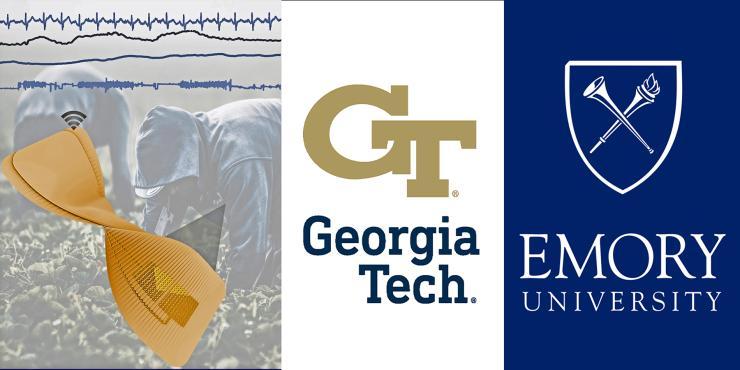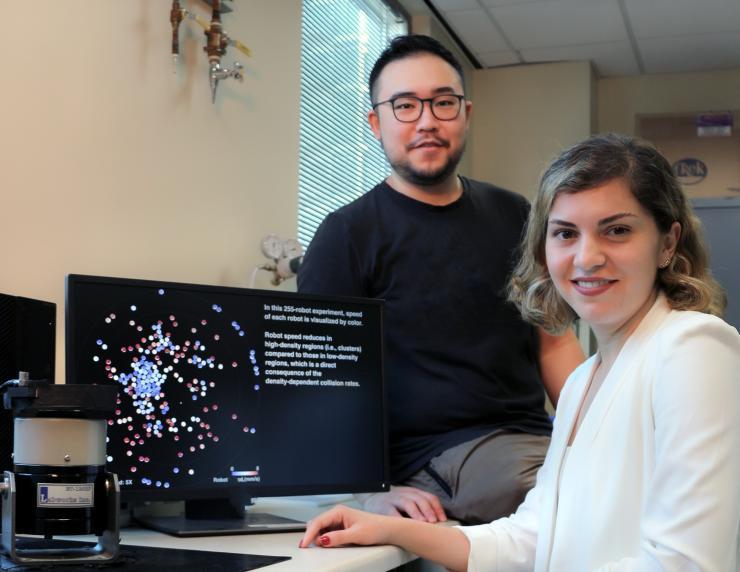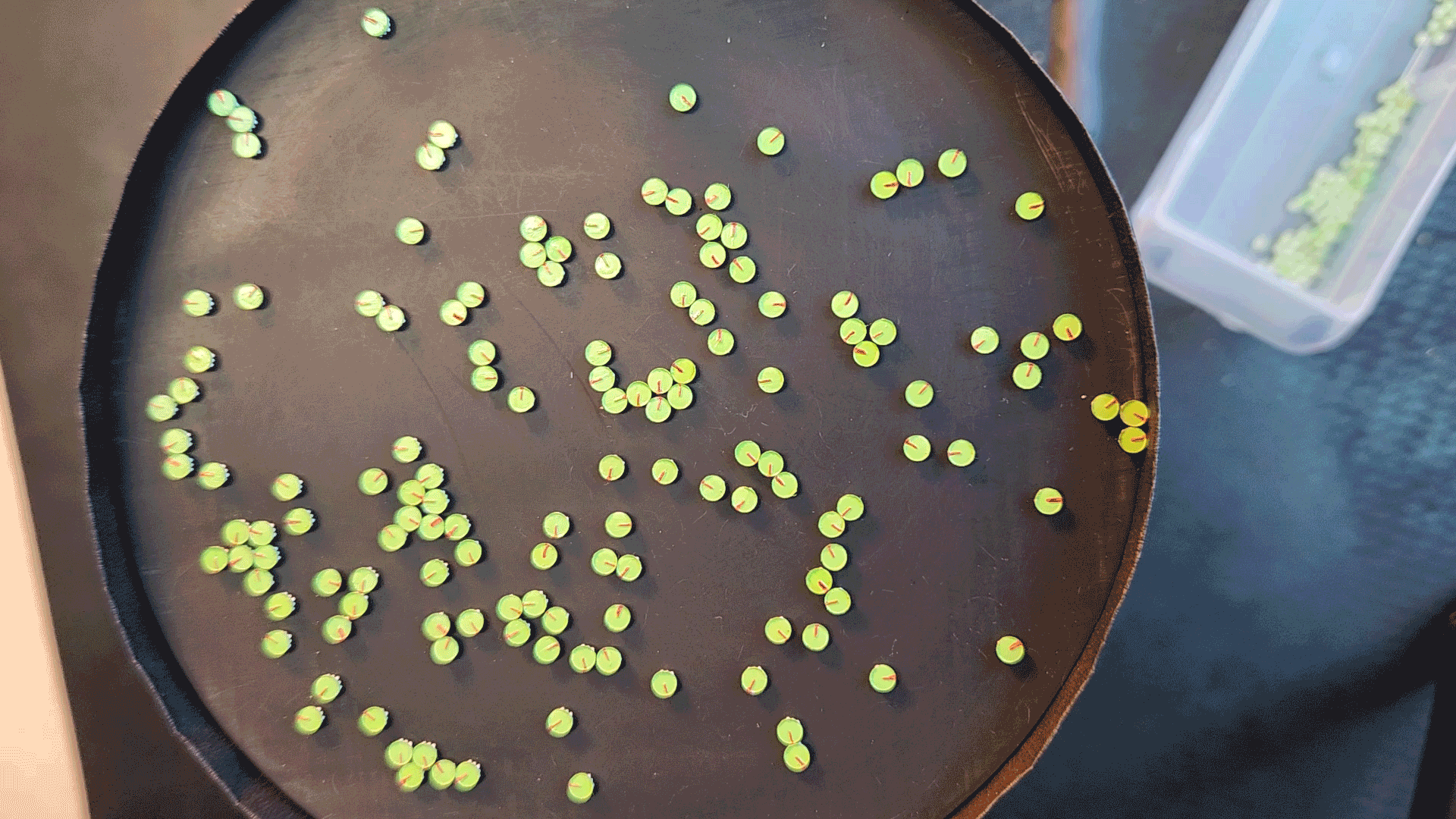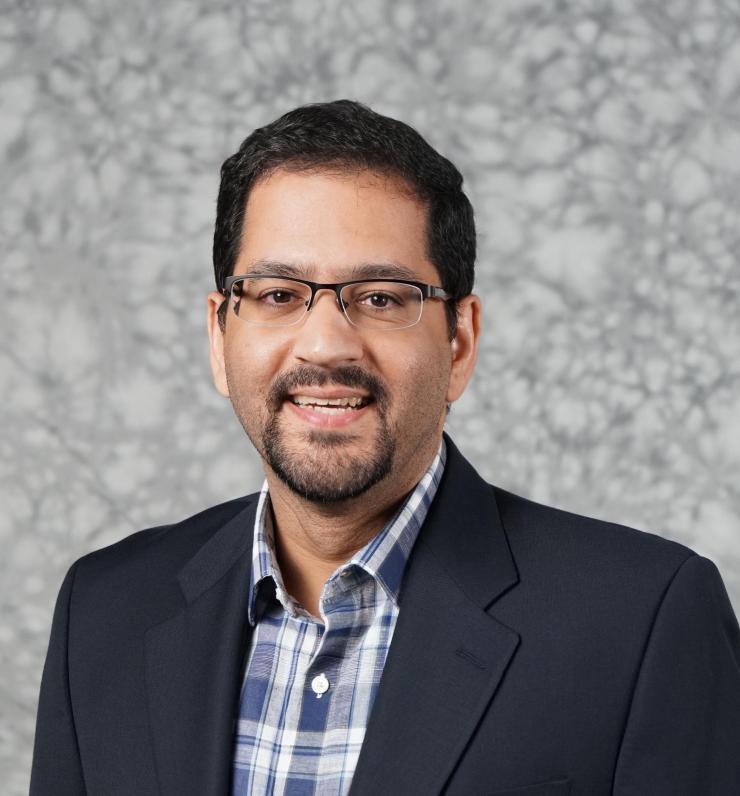Going Back to Basics Yields a Printable, Transparent Plastic That’s Highly Conductive
Dec 01, 2022 — Atlanta, GA

A strip of flexible, transparent, and highly conductive plastic film called PEDOT(OH) created by Georgia Tech chemists and engineers. (Photos Courtesy: James Ponder)
It was a simple idea — maybe even too simple to work.
Research scientist James Ponder and a team of Georgia Tech chemists and engineers thought they could design a transparent polymer film that would conduct electricity as effectively as other commonly used materials, while also being flexible and easy to use at an industrial scale.
They’d do it by simply removing the nonconductive material from their conductive element. Sounds logical, right?
The resulting process could yield new kinds of flexible, transparent electronic devices — things like wearable biosensors, organic photovoltaic cells, and virtual or augmented reality displays and glasses.
“We had this initial idea that we have a conductive element that we're covering with a nonconductive material, so what if we just get rid of that,” said Ponder, who earned a Ph.D. in chemistry at Georgia Tech and returned as a research scientist in mechanical engineering. “It's a simple idea, and there were so many points where it could have failed for different reasons. But it does work, and it works better than we expected.”
Joshua Stewart
College of Engineering
Georgia Tech, Emory researchers receive $2.46 Million Grant to Develop Intelligent Tools for Assessing Heat Exposure Effects
Nov 22, 2022 — Atlanta, GA

Georgia Tech and Emory researchers are collaborating on developing a multi-sensor patch to predict symptoms of heat-related health issues for farmworkers.
The National Institute of Environmental Health Sciences has awarded a $2.46 million grant to Emory University and Georgia Institute of Technology researchers to develop a multi-sensor biopatch for farmworkers that can predict symptoms of heat-related illness, dehydration, and acute kidney injury.
The four-year grant will allow the team to develop a wearable wireless unit for farmworkers with sensors that can integrate key physiological signals, predict adverse heat-related medical events, and generate warnings about them in real time.
“When you think about people who work outside all day, and that includes construction workers and landscapers as well as farm workers and others, they are exposing themselves to potentially dangerous heat-related conditions,” says W. Hong Yeo, a Woodruff Faculty Fellow and associate professor in mechanical and biomedical engineering at Georgia Tech, and one of the principal investigators on the project, who is leading development of the biopatch.
The findings of the project will lead to an intervention study in which data are sent from the biopatch to an Android device. The team will develop artificial intelligence (AI) tools for predicting study outcomes. In future research, the team envisions that data sent to the Android from the biopatch will be processed with these tools. After processing, warnings may be sent to workers from the Android device as necessary, which will help determine if the technology can reduce morbidity associated with occupational heat exposure.
Escalating trends of increasing environmental temperatures place marginalized populations, such as agricultural workers who have routine occupational exposure to hot, humid environments, at increased risk for the acute health effects of heat exposure, according to Vicki Hertzberg, lead principal investigator on the project and a professor at the Emory University Nell Hodgson Woodruff School of Nursing.
“Heat-related illness and dehydration are particularly insidious, as they can quickly progress from moderate discomfort to confusion and impaired judgment, thereby diminishing the affected worker’s ability to seek necessary medical attention,” she says. “A hand-held device with clear information about heat illness will help farmworkers know when to seek help.”
Joining Hertzberg and Yeo as a principal investigator is Li Xiong, a Samuel Candler Dobbs professor in the Emory Department of Computer Science. Xiong will lead the development of prediction models associated with the research, and Yeo will lead the development of the biopatch.
“We know that once we can get continuous physiological data in real time, then we can prevent this problem,” says Yeo, a Woodruff Faculty Fellow and associate professor in mechanical and biomedical engineering at Georgia Tech, who also is director of the Georgia Tech IEN Center for Human-Centric Interfaces and Engineering. “Currently, it’s very hard to measure real-time events because of the limitations of existing sensor or device technology.”
Conventional wearable devices tend to be rigid, heavy, and bulky – not useful for workers who spend a lot of time moving around.
Xiong adds, “Once we have these continuous data, then the challenge is how to fuse these multimodal data in real time and make reliable predictions for interventions. I’m looking forward to working with the team to develop the AI tools and test them in the field.”
Emory School of Nursing assistant professor Roxana Chicas will lead the field team assessing the use of the biopatch on outdoor workers, and Jeff Sands, professor in the Emory Department of Medicine and director of the Emory University Division of Renal Medicine, will provide renal expertise. Completing the team is Nezahualcoyotl Xiuhtecutli, executive director of the Farmworker Association of Florida. The association and the School of Nursing have had a strong partnership in community-based research among Florida farmworkers.
Writer: Melanie Kieve
Materials Characterization Facility XRD Symposium
The Materials Characterization Facility, in collaboration with Rigaku, will be hosting a workshop on X-ray diffraction on January 5-6, 2023. The first day will feature seminars from researchers from institutions including but not limited to Clemson, Emory, and Florida State University. Day two will feature hands-on training and the application of techniques. Attendees will also see the capabilities of the tools and the software.
Registration is required. Please reserve your seat by Friday, December 30, 2022.
The 2023 Atlanta Science Festival
Returning March 10–25, 2023, the Atlanta Science Festival is an annual public celebration of local science and technology. Curious people of all ages will explore the science and technology in our region and see how science is connected to all parts of our lives.
Join us as we partner with Science ATL to bring STEAM events to curious community members of all ages! The Georgia Tech Science and Engineering Day will occur as part of the festival on Saturday, March 11 in the Georgia Tech Bioquad area.
2023 Brumley D. Pritchett Lecture and Institute for Materials Symposium on Materials Innovations
Materials research at Georgia Tech is broad — from fundamental physics and chemistry to simulation, synthesis, processing, and characterization, to properties that impact structural, chemical, biomedical, electronic, optical, magnetic, thermal, and energy applications. The Institute for Materials (IMat) brings together faculty and students studying materials from across campus to accelerate the pace of research, discovery, deployment, and applications.
Using Vibrations to Control a Swarm of Tiny Robots
Nov 09, 2022 — Atlanta, GA

Zhijian Hao (left) and Azadeh Ansari in their lab.
Vibrating tiny robots could revolutionize research.
Individual robots can work collectively as swarms to create major advances in everything from construction to surveillance, but microrobots’ small scale is ideal for drug delivery, disease diagnosis, and even surgeries.
Despite their potential, microrobots’ size often means they have limited sensing, communication, motility, and computation abilities, but new research from the Georgia Institute of Technology enhances their ability to collaborate efficiently. The work offers a new system to control swarms of 300 3-millimeter microbristle robots’ (microbots) ability to aggregate and disperse controllably without onboard sensing.
The breakthrough is unique to Georgia Tech’s expertise in electric and computer engineering and robotics and its push for interdisciplinary collaborations.
“By collaborating with roboticists we were able to ‘close the gap’ between single robot design and swarm control,” said Azadeh Ansari, an assistant professor in the School of Electrical and Computer Engineering (ECE). “So I guess the different elements were there, and we just made the connection.”
The researchers presented the work, “Controlling Collision-Induced Aggregations in a Swarm of Micro Bristle Robots,” in IEEE Transactions on Robotics.

How microbots swarm
The Challenges of Microbots
While larger robots can control movement through sensing the environment and wirelessly sending this data to each other, microbots do not have the capacity to carry the same sensors, communications, or power units. In this study, the researchers instead utilized inter-robot physical interactions to encourage robots to swarm.
“Microbots are too small to interpret and make decisions, but by using the collision between them and how they respond to frequency and the amplitude of global vibration actuation, we could influence how individual robots move and the collective behaviors of hundreds and thousands of these tiny robots,” said Zhijian Hao, an ECE Ph.D. student.
These behaviors, or motility characteristics, determine how microbots move linearly and the randomness in their rotation. By using vibration, the researchers could control these motility characteristics and perform motility-induced phase separation (MIPS). The researchers borrowed the concept from thermodynamics, when an agitated material can change phases from solid to gas to liquid. The researchers manipulated the level of vibration to influence the microbots to form clusters or disperse to create good spatial coverage.
To better understand these phase separations, they developed computational models and a live tracking system for the 300-robot swarm using computer vision. These enabled the researchers to analyze microrobots’ behavior and motion data that give rise to the swarm’s characteristics.
“This project is the first complete pipeline using this MIPS that can be generalized to different microbot swarms,” Hao said. “We hope people will find that using physical interactions is another new way to control the microbots, which initially was very difficult to do.”
Collaborating for Innovation
A Georgia Tech seed grant from the Institute for Robotics and Intelligent Machines (IRIM) and the Institute for Electronics and Nanotechnology enabled this high-risk research.
The success of the project can be attributed to the interdisciplinary nature of the research. While the ECE researchers had expertise in building microelectromechanical systems (MEMS) to fabricate technology such as computer chips or microbots, the robotics researchers brought modeling experience. Ansari first created microbristle bots in 2019 from 3D-printed polymers, which seeded the collaboration with IRIM Director and Professor Seth Hutchinson and Professor Magnus Egerstedt, now at University of California, Irvine, and their Ph.D. students Sid Mayya and Gennaro Notomista.
“We knew more about how to build micro devices and actuate them, and they knew more about the algorithms, modelings, and the closed-loop and open-loop control,” Ansari said. “So, it was very good interdisciplinary work because each group benefited from the new perspectives that the others brought to this.”
CITATION: Z. Hao, S. Mayya, G. Notomista, S. Hutchinson, M. Egerstedt and A. Ansari, "Controlling Collision-Induced Aggregations in a Swarm of Micro Bristle Robots," in IEEE Transactions on Robotics, 2022, doi: 10.1109/TRO.2022.3189846.
Tess Malone, Research Writer/Editor
Connect your ORCID iD with Georgia Tech
Nov 08, 2022 — Atlanta, GA

Tech Tower
Beginning in 2023, researchers applying for many sources of federal funding will be required to have a persistent identifier (an ORCID iD). Fortunately, there is an easy way to meet this requirement: creating an ORCID iD, which also adds value, including addressing more specific research activity disclosure requirements.
As a Georgia Tech researcher, you need to register with ORCID and connect it with Georgia Tech.
Register & Connect Your ORCID iD
Georgia Tech is a university that receives more than $50 million in federally funded research per year; therefore, we are required by the National Security Presidential Memorandum-33 (NSPM-33) to strengthen and standardize disclosure requirements for federally funded awards.The first step in protecting your research at Georgia Tech is to register and connect your ORCID iD with Georgia Tech. Learn more.
Georgia Tech Packaging Research Center Collaboration with SKC Leads to $600 Million Semiconductor Manufacturing Site in Georgia
Nov 07, 2022 — Atlanta, GA

Absolics, Inc., a subsidiary of SKC Co., broke ground on a new semiconductor manufacturing facility in Covington, Georgia, on November 1. The $600 million facility will produce a revolutionary glass substrate that can “significantly increase the performance and energy efficiency of chipsets.” It is expected to create more than 400 skilled jobs in Georgia.
In a previous announcement about the facility, Georgia Tech President Ángel Cabrera said “We’re delighted that Georgia Tech’s investment in packaging research and advanced circuitry over the last 25-30 years has contributed to Georgia’s selection as the best place for the company to manufacture their state-of-the-art semiconductor technology. We look forward to further collaboration so we can work together to lead the region in developing the best engineering talent to work in this crucially important field.”
Georgia Tech 3D Systems Packaging Research Center (PRC) Director Madhavan Swaminathan and his team worked closely with SKC on this project. According to Swaminathan, glass as a substrate material has seven useful attributes or properties, namely smoothness which enables dense connectivity between chips; tailorable thermal expansion which improves reliability; stiffness which eases manufacturability; zero moisture absorption that improves stability; low thermal conductivity which isolates hotspots; dielectric insulation that improves performance; and large area panel processing which reduces cost.
“The PRC has been pioneering glass substrate technology for many years and we have been continuing to advance this technology working closely with SKC and several other supply chain companies along with state and federal support,” said Swaminathan, who also participated in the monumental groundbreaking ceremony. “With applications emerging in artificial intelligence, high-performance computing, and high-end communications, we expect glass substrates as being the next technology of the future. By creating the world’s first glass substrate factory, we see Absolics as being uniquely positioned to productize and commercialize this technology through their vast skill set, know-how, and customized manufacturable solutions. In the years ahead we look forward to continuing our close collaboration with Absolics in several areas that include research, education, and workforce development.”
Bakir to Serve as Interim Director of Packaging Research Center
Oct 31, 2022 — Atlanta, GA

Muhannad Bakir
Muhannad Bakir has been named interim director of the Institute for Electronics and Nanotechnology’s Packaging Research Center (PRC). Bakir will assume this role on December 1, 2022.
"I am delighted that Professor Bakir has agreed to serve the campus community in this capacity,” said Michael Filler, IEN’s associate director for research programs. “His deep expertise in electronics packaging, proven leadership, and steady judgement will be an asset to PRC during this transition.”
The PRC is a graduated National Science Foundation Engineering Research Center focusing on advanced packaging and system integration leading to System on Package technologies. The Center conducts research and education in all aspects of electronics packaging that includes design, materials, process, assembly, thermal management, and integration driven by applications, which includes broad areas such as high-performance computing, artificial intelligence, automotive, broadband wireless, and space.
The PRC team consists of 29 faculty from five schools at Georgia Tech, 11 researchers and administrative staff, more than 50 graduate and undergraduate students, and several visiting engineers. This is enabled through collaboration with 48 industry and government organizations and 14 universities in North America, Europe, and Asia.
“I look forward to collaborating with the campus community in this new capacity to continue Georgia Tech’s leadership and forward-looking research initiatives in the areas of advanced packaging, heterogeneous integration, and 3D architectures with our partners in the industry and government,” said Bakir.
Bakir, who also serves as the Dan Fielder Professor in the School of Electrical and Computer Engineering and leads the Integrated 3D Systems Group, brings a wealth of experience to his new role as PRC interim director. He and his research group have received more than thirty paper and presentation awards including six from the IEEE Electronic Components and Technology Conference, four from the IEEE International Interconnect Technology Conference, and one from the IEEE Custom Integrated Circuits Conference (CICC). His group was also awarded the 2014 and 2017 Best Papers of the IEEE Transactions on Components Packaging and Manufacturing Technology.
Bakir is the recipient of the 2013 Intel Early Career Faculty Honor Award, 2012 DARPA Young Faculty Award, 2011 IEEE CPMT Society Outstanding Young Engineer Award, and was an Invited Participant in the 2012 National Academy of Engineering Frontiers of Engineering Symposium. He is the co-recipient of the 2018 IEEE Electronics Packaging Society Exceptional Technical Achievement Award “for contributions to 2.5D and 3D IC heterogeneous integration, with a focus on interconnect technologies.” He is also the co-recipient of the 2018 McKnight Foundation Technological Innovations in Neuroscience Awards. In 2020, Bakir was the recipient of the Georgia Tech Outstanding Doctoral Thesis Advisor Award.
Bakir serves as a senior area editor for the IEEE Transactions on Components, Packaging and Manufacturing Technology and was previously an Editor for IEEE Transactions on Electron Devices. He has also served as a Distinguished Lecturer for IEEE EPS.
Georgia Electronic Design Center Seminar Series
Intercellular Communication: Can It Be Mediated by Electromagnetics?
Featuring Professor Kamal Sarabandi, Electrical and Computer Engineering, Radiation Lab, University of Michigan
